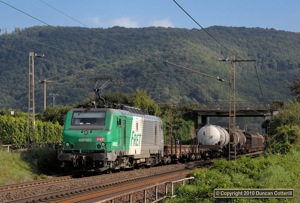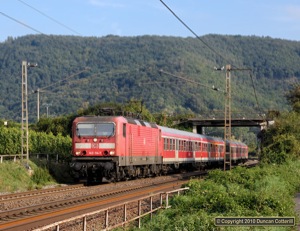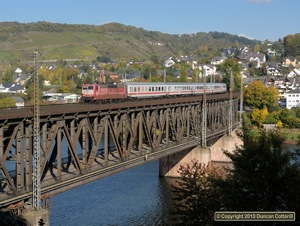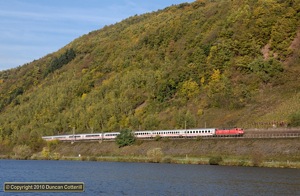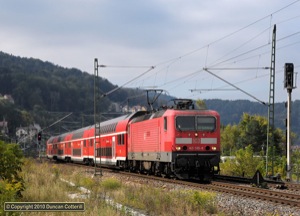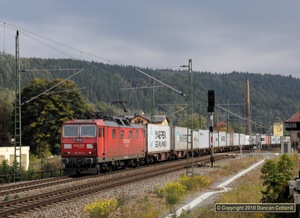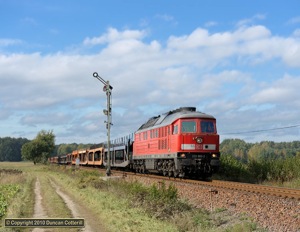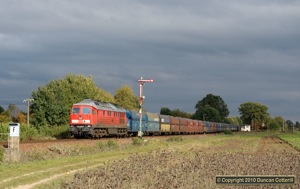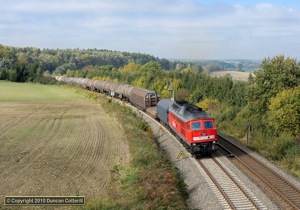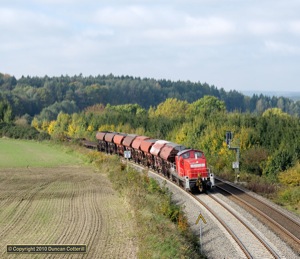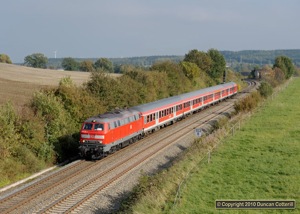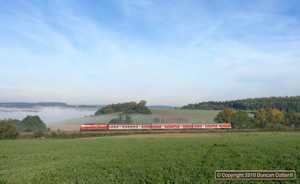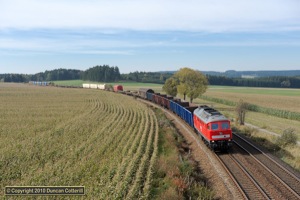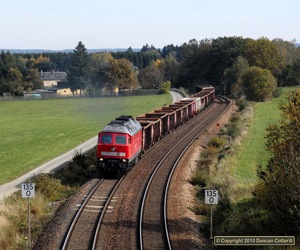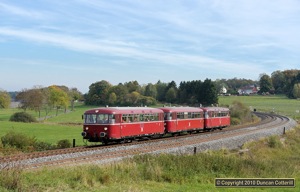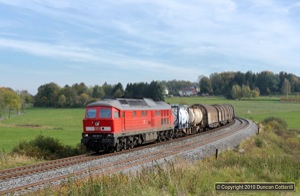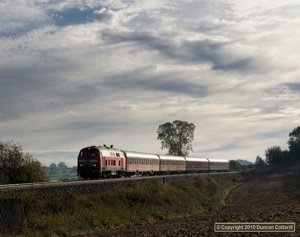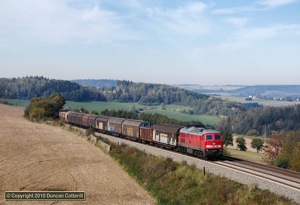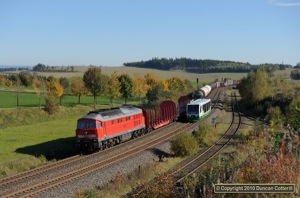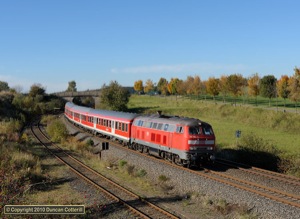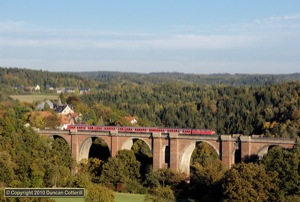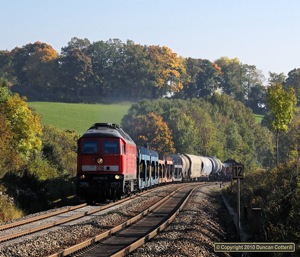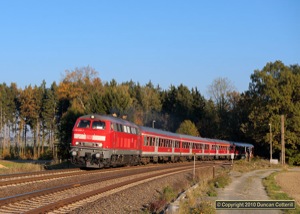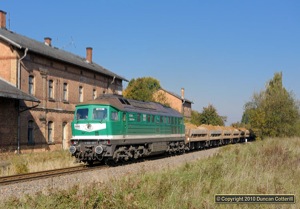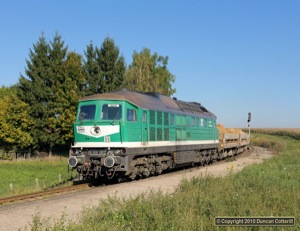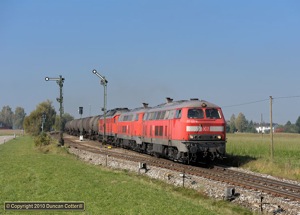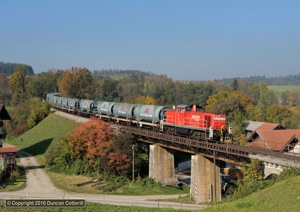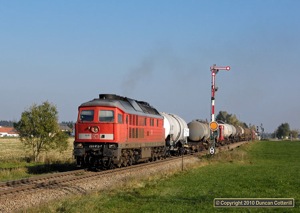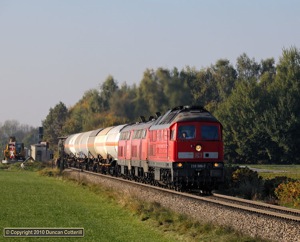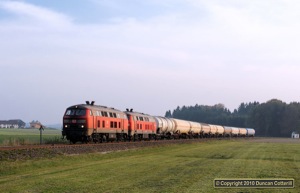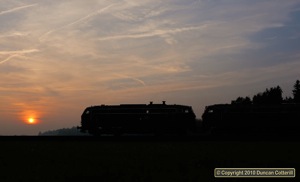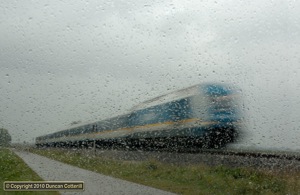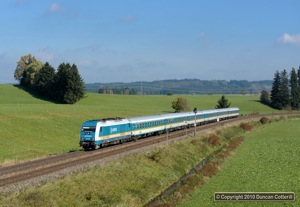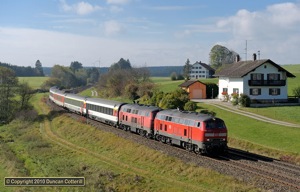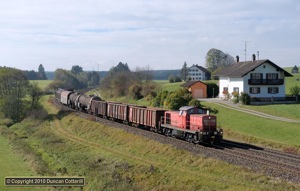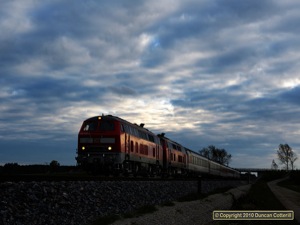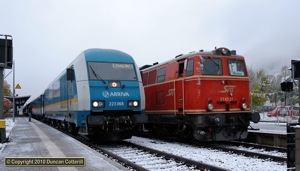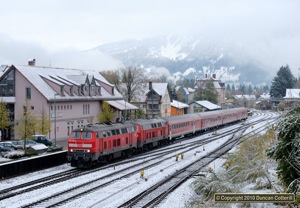To Deutschland for Diesels
30 September - 21 October 2010
Report by Duncan Cotterill
Introduction
I’d planned a three week trip to Germany and the north-west of the Czech Republic by car but it didn’t turn out as expected. The trip started with a visit to the Koblenz - Trier line in the Mosel Valley then moved east to the Elbe Valley, east of Dresden. The plan was then to visit the Liberec - Zawidow line in the Czech Republic but it was closed for engineering work so I diverted to the Hoyerswerda - Horka line, north-east of Dresden, and then spent a few days on the superb Reichenbach - Hof line. There was also a quick visit to the Wismut Werkbahn, an industrial operation near Gera. The final part of the trip involved visits to the Mühldorf area and the Allgäubahn (München - Kempten - Lindau) in Bayern before finally returning home via the Mosel.
This page summarises what was seen. For train by train details with loco numbers etc, go to the Day by Day pages.
Mosel Valley
(30 Sep, 01, 21 Oct)The electrified double-track main line through the Mosel Valley is busy, scenic and relatively easy to reach from Calais by road. It’s also home to the increasingly rare class 181 electrics and sees a good variety of locos from DB and other operators on passenger and freight.
Passenger Trains
The Mosel Valley line enjoys a good passenger service with a local and a limited stop train each way, every hour. Most of the local passengers were worked by modern class 425 or 426 EMUs running between Koblenz and Trier but there were occasional class 143s on push-pull sets as well.The majority of limited stop services were RegioExpresses running between Koblenz and Saarbrücken. These were usually formed of class 143s on the west end of double-deck push-pull sets but, occasionally, they could be the other way round. Every few hours, the RE would be replaced by a class 181 on an InterCity train to or from Luxembourg via Saarbrücken. In addition to locos in the standard red, blue/beige 181.211 and orientrot 181.215 were also seen. The 11:22 RE departure from Koblenz was the exception to the loco worked regime and was a 425 on both days I saw it.
An unexpected sighting on 1 October was Centralbahn 10019, an ex SBB class Re4/4i, on a westbound special. The Bullay – Traben-Trarbach branch was worked by a class 628 DMU.
How long the 181s will remain in service is unclear but it appears that CFL plans to order new units for an hourly Koblenz - Luxembourg service that will replace both the RE and IC trains from 2013.
Freight Traffic
Freight traffic averaged around one train each way every hour with a wide variety of DB classes being seen. Class 185s were the most common but classes 140, 151, 152, 155, 189 and 294 were also seen. A pair of 151s was seen on one of the heavy iron ore trains to Dillingen on 30 September but all subsequent ore trains seen were hauled by pairs of 189s.On 1 October, Fret SNCF BB 37000s worked most of the general freight on the line. By 21 October SNCF were in the middle of one of their all too frequent strikes but the trains still seemed to run, albeit hauled by DB class 185s.
Other operators’ engines were also seen on 1 October, including an HGK 185, a CFL Cargo 4000, a Rurtalbahn class 66 and two RTS class 2016s, but on 21 October DB locos worked every freight seen.
Photography
The Moselstrecke is very scenic, running in a steep sided valley between slopes covered in vineyards. The river and the bridges at Eller and Bullay add to the interest as do the picturesque towns and villages along the route. Needless to say, there are many good photo positions but they’re not always easy to find or easy to get to.I did find a number of good spots, particularly in the Winningen area and also around Bullay, but have only scratched the surface so far. The weather didn’t help with continuous rain on the first day and, apart from Winningen where the sun came out in the afternoon, almost total overcast on the second. Fortunately, my final day on the line was blessed with wall to wall sunshine so I didn’t come away completely empty handed.
Dresden and the Elbe Valley
(03-04 October)A long drive on a dismal and wet 2 October took me 500km across Germany to Dresden and the Elbe Valley. I’d been here before in July (see report) and found the situation largely unchanged.
Passenger Trains
As expected, the half hourly trains on S-Bahn line 1 (Meißen-Tr. - Dresden - Schöna) were all worked by class 143 electrics coupled to the east end of Dosto push-pull sets. The changeover to class 145 hadn’t begun at this stage. Czech class 371 electrics worked all the 2-hourly EC trains seen east of Dresden, except EN459, which had the expected ÖBB class 1216. An ex-ÖBB class 1042, now belonging to Centralbahn, was seen on a passenger special towards Dresden on 4 October.Freight Traffic
Despite being a Sunday, 3 October was very good for freight with 24 trains being seen around Königstein in less than 9 hours, averaging almost 3 trains per hour. The following day was almost as busy. One change noted from July was an increase in the number of trains hauled by DB class 189s and a corresponding decrease in the number of class 180s seen. No other DB freight classes were seen east of Dresden but the 180s’ Czech counterparts, class 372s, were still very common.Private operators were very much in evidence with ITL locos of classes 152, 185 and 481 (Swiss 145) dominating. There were also a couple of MRCE class 189s and triple-headed RBH class 143s, a Pressnitztalbahn class 145 and an unidentified V100.
Photography
My intention was to have another go at some of the shots I’d tried in July but hadn’t really got to my satisfaction. Despite good forecasts on both days, the weather was almost totally overcast and very few trains passed in sun. Cloud wasn’t the only problem as I’d underestimated how long it would take for the shadows to clear the track at many locations in the valley. While the line would look great in autumn colours, there wouldn’t be too many places where the sun actually got in to illuminate the trains.Hoyerswerda - Horka
(05-06 October)Faced with another overcast day in the Dresden area, I decided to check out some potential photspots on the Hoyerswerda – Horka line, north-east of Dresden. The line continues over the border from Horka to Wegliniec in Poland and carries some international freight traffic. It isn’t at all scenic and hadn’t appeared to be very busy when I’d ridden it in July but it seemed worth having another look. In the event, the effort wasn’t wasted and I returned to the line the following day after discovering that my intended destination, the Liberec – Zawidow line in the Czech Republic, was closed for engineering work.
Passenger Trains
As expected, the passenger services were all worked by class 650 single-car DMUs belonging to ODEG.Freight Traffic
Freight traffic didn’t appear to be very heavy on 5 October but I spent a lot of time moving between potential locations and probably missed a few trains. On 6 October there were six freights in six hours, all hauled by DB class 233s except for the Niesky – Kodersdorf-Sandberg pick-up goods, worked by a class 298. The principal traffic appeared to be coal, carried in colourful PKP hoppers, but there was also some general freight and the odd train of cars. A German enthusiast I met indicated that the through freights might finish soon.Photography
There are a few reasonable photo locations on the line and I found a couple of open spots between Lohsa and Uhyst, not far from Hoyerswerda. There were more spots around Särichen, just west of Horka, where the junction with the chord connecting to the Cottbus – Görlitz line is protected by semaphore signals. There was a little sunshine on 6 October and I managed to get a couple of reasonable shots around Särichen.The line isn’t the most photogenic in Germany but anywhere that averages one diesel freight an hour needs to be taken seriously these days. I’m also developing a taste for the old Ludmillas and this line has more than most.
Postscript
The line was temporarily closed between Hoyerswerda and Klitten from 12 December 2010 to allow stabilisation work on the edge of a flooded former opencast mine that the line runs alongside. Until it reopens at the end of 2011, passenger trains on the closed section have been replaced by buses and freights have been diverted via Cottbus and Spremberg, regaining the original route at Horka. Double tracking and electrification are scheduled to be complete in 2014. (DC 01/01/2011)Reichenbach - Hof
(07-11 October)When I left the UK, this line was hardly on my radar. I was aware that it might have a few diesel freights and was due to be electrified but that was about it. Almost by chance, I decided to have a look while on the way to Dresden and found some superb locations. When the Czech part of the trip fell through, there wasn’t any doubt about where to go. The double track line is one of the oldest in Germany, dating from the 1840s and runs through the attractive Vogtland landscape, winding around the rolling hills and crossing a couple of spectacular viaducts over the Göltzsch and Elster valleys.
Passenger Trains
Local services on the line are operated by the Vögtlandbahn using class 642 and 654 DMUS. The 654s are known, none too affectionately, as “Washing Machines” by local enthusiasts. There are also RegioExpress and InterRegioExpress services linking Dresden with Nürnberg and REs from Leipzig to Hof. Most of these are worked by DB class 612 tilting DMUs but there was also a daily turn for a class 218 on a push-pull set, running Leipzig – Hof – Leipzig – Hof – Reichenbach – Hof - Leipzig. Contrary to what the diagram suggested, the loco was always at the Hof end of the set.A special went north on 8 October worked by Passauer Eisenbahnfreunde’s pair of class 798 railbuses sandwiching a class 998 trailer.
Freight Traffic
There weren’t many freights on the line but there were a couple of regular eastbounds and additional freights turned up occasionally. The regular trains (10:46 and 14:46 from Hof, 11:28 and 15:28 at Plauen) were usually hauled by DB class 232s although a 233 appeared on one occasion. Other freights seen were a DB 241 on a scrap train, a 294 on a pick-up goods, Pressnitztalbahn’s white 223.144 on a container train and an MRCE class 223 on an oil train, banked by a pair of Adam 202s.Photography
This must have been a marvellous line to photograph when everything was loco hauled. It’s still very good but there’s a lot of hanging about between trains, unless you like photographing units. The good photo locations are too many and varied to list here but the Herlasgrün to Jocketa and Schönberg to Grobau sections were particularly good.The weather wasn’t perfect during my time on the line but it was the best of the trip and I managed to get a reasonable selection of shots in good light.
My visit was timely as electrification work had just started at the Reichenbach end of the line but the masts hadn’t yet reached the most scenic parts of the route, west of Herlasgrün. I’d like to go back and take some more pictures but the poles will probably be up at some locations before I get the chance. I also heard rumours that the freights might be diverted away from the line while it’s electrified, so it may already be too late. Let’s hope not.
Wismut Werkbahn
(11 October)This was another line that I was barely aware of before the trip started but it was brought to my attention by a local gricer I met on the Reichenbach – Hof line.
The Wismut Werkbahn is an industrial line that used to serve the uranium mines around Ronneburg, near Gera. Its main function now is transporting materials for use in the environmental restoration of the former mining sites. The line is over 20km long and takes sand from a loading point at Kayna, north of Ronneburg, to the old mine sites south of the town. It crosses DB’s Gera – Gößnitz line on the flat at Raitzhain, east of Ronneburg.
Sand trains run every 2 hours or so and are hauled by a fleet of five V300 diesels, re-engined ex-DB class 232s painted green. Turnrounds at Kayna are rapid with trains departing only 15 minutes or so after they arrive. I didn’t manage to find out exactly where the trains run to, or whether they serve multiple locations.
The line isn’t really scenic although it runs through pleasant countryside, dotted with small villages. There are some good photo positions north of Raitzhain but, as would be expected on a north-south line, most are best in the morning and afternoon and not in the middle of the day when I was there. I didn’t manage to explore the line south of Raitzhain.
Mühldorf Area
(12-15 October)The Mühldorf area, east of München, is one of the best places in Germany to photograph diesel-hauled freights, with plenty of traffic, pleasant locations and a variety of classes in use. I’d been there before in May 2009 and April 2010 but the weather had been poor on both occasions.
Passenger Services
No changes to report since my April visit with class 628 DMUs on most services on the Traunstein, Freilassing and Burghausen lines. I wasn’t in position to see any of the turns booked for class 218s but have no reason to suppose that they had changed.Freight Traffic
Freight Traffic remained heavy, particularly on the Burghausen branch, which serves the huge industrial plants at Gendorf and Wackerwerk. The best day for volume was Thursday 14 October, when no fewer than 14 freights were seen, 12 of them on the Burghausen branch. Even on the quietest day, Tuesday 12 October, I saw six trains, despite spending several hours visiting a remote spot on the Freilassing line to photograph just one train.The only significant change I detected since April was a slight decline in the number of class 217 in use. Five had been seen in April but only four were seen this time, 217.002/012/017/021. Pairs of class 225s hauled most freights with class 233s or pairs of 217s on most of the remainder. The afternoon bins to Traunstein, which runs via Freilassing continued to be worked by a class 294 despite being booked for a class 225.
The Traunstein line between Garching, Schalchen and Trostberg is busier for freight than it would appear with a number of trip freights shuttling back and forth each day behind a class 294. This section runs alongside the Alz Canal and is quite photogenic.
For several months there had been rumours that DB would divert some ECR class 66 or 77 to the Mühldorf area and I was relieved not to see any during my visit. It appears that I was only just in time as the Sheds started work around a week after I left.
Photography
My previous trips to the Mühldorf area had been plagued by poor light and this one continued the trend with the weather deteriorating badly after the first day. I did manage to get a few of the shots I was after but many more remain elusive.One of the great attractions of the area, the semaphore signals on the Burghausen branch, are clearly on the way out with new colour lights installed at Altötting and Pirach. Fortunately the old signals were still in use at the time of my visit.
While I’d like to go back, it remains to be seen whether enough duties remain for the older classes to justify a return visit.
Allgäubahn
(15-20 October)The Allgäubahn from München to Lindau via Kempten is is one of my favourite German lines but it doesn’t have that many loco hauled trains under normal circumstances. My visit was timed to coincide with the temporary closure of the parallel route between Hergatz and Kißlegg and the diversion of three pairs of EuroCity trains via Kempten and Immenstadt. I’d been here before in July 2006, August 2007, August 2008, April 2009 and May 2009.
Passenger Services
There had been very few change since my previous visit to the line in May 2009. The München – Lindau trains continued to be hauled by ALEX class 223s but an ex-ÖBB class 2143 (on hire from SVG) worked the Oberstdorf portions from Immenstadt. Most of the DB Regio trains were worked by class 612 DMUs with a few class 642s on RB services. Kempten based DB Regio class 218s continue to reach Immenstadt and Oberstdorf on a handful of services.One pair of EC trains was booked to run via Kempten and Immenstadt with the other three pairs usually running via Memmingen and Kißlegg. The EC trains were all booked for pairs of Mühldorf class 218s, irrespective of which route they took. The daily IC trains from Oberstdorf to Leipzig and Augsburg were hauled by Ulm 218s, with the Leipzig train double headed north of Immenstadt.
On several occasions bad weather drove me north to the area around Buchloe where there were more class 218s on Regio services. All the trains seen on services from München to Füssen, Kaufbeuren and Memmingen were worked by Kempten class 218s on push-pull sets. Trains from Augsburg to Füssen were all class 628 or 642 DMUs.
Freight Traffic
There’s very little freight traffic on the Allgäubahn and the other lines in the area. The one train that appeared to be regular was a 294 hauled pick-up goods leaving Kempten around 09:45 and stopping for a couple of hours at Günzach before departing around 12:45 for Buchloe. Mittelweserbahn 275.102, a Vossloh G1206, was working ballast trains in the Günzach area.Photography
It was pretty grim with only two or three hours sunshine in almost six days on the line. The trains produced as expected and the locations looked as fabulous as ever but, even if it wasn’t raining, it wasn’t worth trying to photograph in the gloom. Fortunately, there should be more EC (and hopefully freight) diversions over the next few years, not to mention the anticipated working of 6 and 7 coach ALEX trains through to Lindau when the Oberstdorf branch is closed for engineering work.Comments and Conclusions
Overall, the trip felt like hard work while it was in progress with the first and last weeks dogged by dull, wet weather and the middle week having to be replanned on the fly. It’s hard to stay positive when it’s all falling apart around you and I have to admit, on several occasions, wondering whether I shouldn’t just give up and go home. Looking at the pictures now, a couple of months later, I’m very glad I stuck with it. After all, it will probably soon be impossible to get shots of 232s in the Vogtland hills, pairs of 217s passing the semaphores on the Burghausen branch or 181s sweeping through the vineyards beside the Mosel.
The Elbetal and Allgäu visits produced very little of value but I got something worthwhile out of every other location. The Mosel, Hoyerswerda - Horka, Reichenbach - Hof and Wismut were completely new for me and, despite it being my third visit, almost all the good shots around Mühldorf were at new locations. Despite DBs rush to get rid of everything interesting, there’s still a lot worth photographing in Germany. It won’t be too long before I go back.
It was good to meet up with Brian Denton for a couple of days in the Allgäu but disappointing that the weather wasn’t better.
